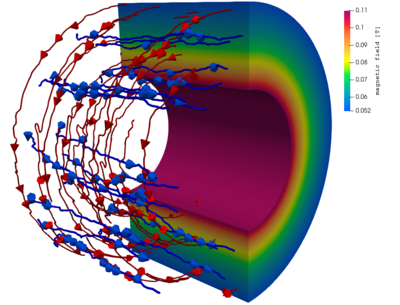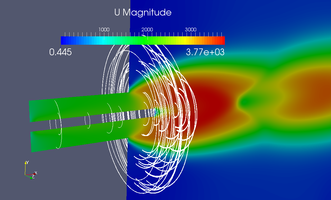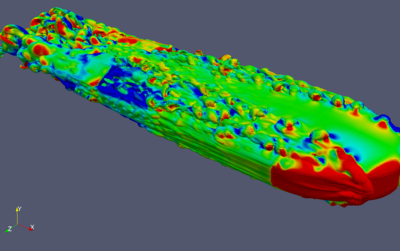Primary research topics in the research group “Thermo-Fluid Dynamics” are around modeling of unsteady processes in fluid and thermo-dynamics resulting from transient microscale phenomena in plasma and gas dynamics. The correlation between momentum transfer and thermo-fluxes is analyzed by disturbance calculation methods and stability evaluations. To achieve this, the dynamics of microscale particles and molecules has to be modeled. Based on statistical physics the molecular motion is described, among other formulations, by the Brownian motion. Physical quantities of molecular flows are described through spectral methods as transport equations for the probability density function over the phase space. The research topic focuses on the combination of flow modeling and the thermodynamic aspects of molecular and turbulent flows.
 |

|
Rarefied Gas Dynamics and Trans-sonic MicroflowsIn the main field of research the frontiers of classical flow descriptions are investigated. High Knudsen numbers lead to a molecular, non-continuous fluid behavior. As a consequence, high Knudsen numbers deny the description of a flow by a continuous approach and additional statistical models have to be defined. In this case, a quasi-continuous transport model for dispersed systems based on transport equations for statistical moments is used. |
 |
|||
 |
|
 |
||||
 |

|
Computational Particle-in-Cell modelling for Plasma Flow
Plasma is the most abundant state of matter in the universe, it consist of ionized atoms or molecules and free electrons.
Compared to ordinary matter it has some special properties, among other there exist long-ranging attraction and repulsion of charges through electrostatic forces,
from which a verity of other fascinating effects emerge. Next to the experimental observation and measuring of plasma in laboratory
settings exist the computational simulation of plasma using a variety of methods, one of which is the modeling as fluid using magneto-hydrodynamics. |
 |
|||
 |
|
 |
||||
 |

|
Electric Propusion Systems for Space TransportThe present situation of space exploration calls for missions beyond the moon and for such missions, chemical propulsion is not a viable option, except for the case of launch vehicles where high thrust is required. Functionally, the inability of chemical propulsion systems to achieve higher exhaust velocities is due to limitation in the maximum tolerable temperature in the combustion chamber and to avoid excessive heat transfer to the walls. |
 |
|||
 |
|
 |
||||
 |

|
Turbulence Modeling: Boundary Layers and Scale TransitioningThanks to numerous technical studies the physical law of periodic flow instability in fluid flows with high Reynolds numbers is well-known. The laminar character (stream lines positioned in laminar layers) is destroyed by perturbations, which diffuse from the wall through the complete flow domain. The change from a steady laminar stream to an unsteady turbulent flow is defined as transient. |
 |
|||
 |
|
 |
||||